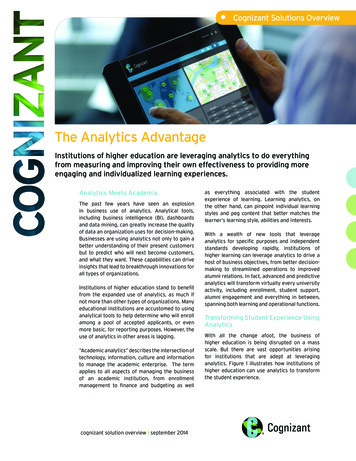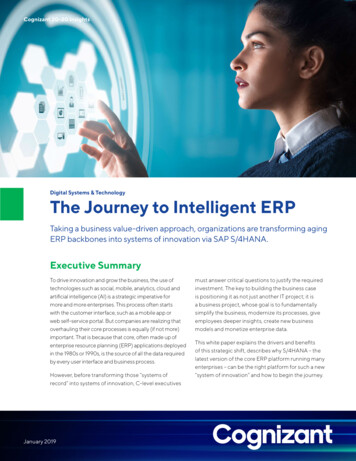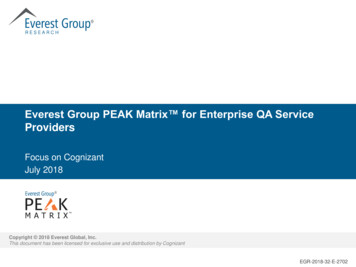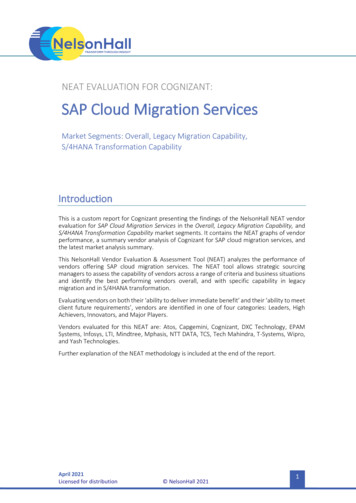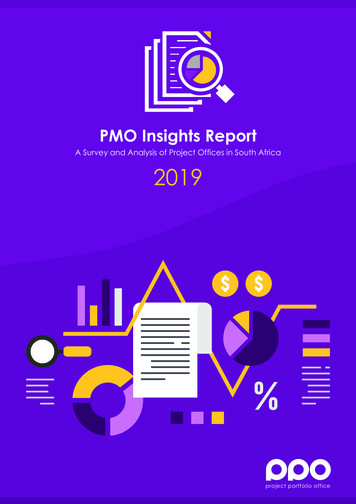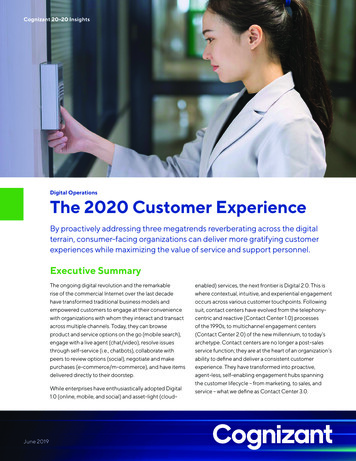
Transcription
Cognizant 20-20 InsightsDigital OperationsThe 2020 Customer ExperienceBy proactively addressing three megatrends reverberating across the digitalterrain, consumer-facing organizations can deliver more gratifying customerexperiences while maximizing the value of service and support personnel.Executive SummaryThe ongoing digital revolution and the remarkablerise of the commercial Internet over the last decadehave transformed traditional business models andempowered customers to engage at their conveniencewith organizations with whom they interact and transactacross multiple channels. Today, they can browseproduct and service options on the go (mobile search),engage with a live agent (chat/video), resolve issuesthrough self-service (i.e., chatbots), collaborate withpeers to review options (social), negotiate and makepurchases (e-commerce/m-commerce), and have itemsdelivered directly to their doorstep.While enterprises have enthusiastically adopted Digital1.0 (online, mobile, and social) and asset-light (cloud-June 2019enabled) services, the next frontier is Digital 2.0. This iswhere contextual, intuitive, and experiential engagementoccurs across various customer touchpoints. Followingsuit, contact centers have evolved from the telephonycentric and reactive (Contact Center 1.0) processesof the 1990s, to multichannel engagement centers(Contact Center 2.0) of the new millennium, to today’sarchetype. Contact centers are no longer a post-salesservice function; they are at the heart of an organization’sability to define and deliver a consistent customerexperience. They have transformed into proactive,agent-less, self-enabling engagement hubs spanningthe customer lifecycle – from marketing, to sales, andservice – what we define as Contact Center 3.0.
Cognizant 20-20 InsightsAccording to data from the International DataCorporation (IDC), worldwide spending on digitaltransformation (DX) technologies will grow to morethan 2.1 trillion in 2019, with a compound annualgrowth rate (CAGR) of 16.8% over the 2014 to 2019forecast period. Spending on DX technologiesin the U.S. will follow a similar trajectory, reachingnearly 732 billion in 2019.1We predict that by 2020, Digital 2.0 technologies,including machine learning, artificial intelligence,biometrics, and robotic automation will furtheraugment Contact Center 3.0 with innovative,personalized solutions. Enterprises that are flexibleand that openly embrace this model will emergeas masters of the customer experience (CX). Butto get there, consumer-facing companies mustbecome well versed in the three megatrends ofDigital transformation 2.0. System convergence for digital efficiencies:The four pillars of digital technologies – systemsof things, systems of intelligence, systemsof engagement, and systems of records –will converge to enable end-to-end digitaltransformation across customer lifecycles toprovide highly personalized customer experiences. Self-service, the new battlefield of CX:Customers are getting savvier and expect2/service on-the-go. In response, enterprises arerapidly investing in self-serve solutions withadvanced automation capabilities that provideseamless service and do not compromisethe experience. Innovative and disruptivetechnologies such as machine learning,biometrics, artificial intelligence, and roboticprocess automation are taking center stage tore-define traditional engagements. Zero-UI: Applying design thinking andexperience-driven Zero-UI will shape the waybusinesses handle new-age customers acrosstouchpoints – affording hassle-free, real-timeexperiences that maximize the CX “wow” factor.Technologies such as virtual and augmentedreality will re-define customer engagementswith a simplistic, experiential interface (UI). (Formore on design thinking, read our Cognizantiarticle Human-Centric Design: ThinkingCan Power Creative Problem Solving, DriveChange, Deliver Value.This white paper explores each of thesemegatrends in detail, with recommendations onhow consumer-facing enterprises can create andenact strategies that will differentiate them todayand in the years to come.The 2020 Customer Experience
Cognizant 20-20 InsightsMegatrend 1: System convergence for digitalefficienciesCX and enhanced user engagement are today’sinescapable business buzzwords. Virtually everyenterprise is examining CX as a critical criterion forbusiness transformation. One of the key investmentareas under CX for all industries is technology thatprovides a holistic digital solution that cuts acrossthe customer lifecycle. While many CXOs areinvesting heavily in digital enablement projects,many are not. Interestingly, research finds that:2 A full 78% of IT projects fail due to lack of align ment with business goals and requirements. Of these projects, 45% are not based onbusiness objectives.This tells us that there is little integration amongvarious operational and strategic componentswithin the organization. Each runs independently –resulting in technology silos. As enterprisesbecome more customer-centric and strive to stayclose to their consumers, technology convergence(bringing together systems that engage, record,and intelligently analyze data from various sources)grows increasingly important. We believe thatmaking systems and related processes morecollaborative (as with any IT-related initiative)requires eliminating organiza tional and technologysilos and investing in systems that prepare theorganization for seamless CX. We have groupedthese key systems under four pillars (see Figure 1).Synchronizing systems around the etingmanagementJourneymappingSystems ofrecordsBPMPersonalizationNext telligence intelligenceCustomeranalyticsSystems BeaconBLE eRobotic processautomation RaspberrypieCustomer360Systems ofengagementService &marketinganalyticsSystems ofthingsE-mailFigure 13/The 2020 Customer Experience
Cognizant 20-20 InsightsSystems of engagementData is rapidly becoming the most valuableresource in any organization. But operational datatoday is often closed and static, locked insidevarious separate systems. As a decision center,the lab is a prime candidate to take advantage oftechnologies such as advanced forms of artificialintelligence (AI) in the form of machine learning(ML), which depends on data.Systems of engagement span traditional channels,such as voice, e-mail, SMS, and fax, along with “newage” digital touchpoints – chat, video chat, social,co-browsing, as well as messaging apps such asWhatsApp – with the purpose of providing a consistent,satisfying, unified experience to end customers.Each customer interaction is automatically routedto and handled by the appropriate channel/agent. This involves analyzing complex data,such as persona traits, demographic information,psychographic details, interaction history, and othertransactional data.Customer interactions are mapped acrosschannels to optimize the communications flow andassure that customers’ experiences align with thecompany’s strategies, and at every encounter. Thisfurther serves to personalize the customer journey.campaigns, product preferences, service issues,etc.). SoR form the core data management layerof an enterprise – providing a complete view ofcustomer personas, product details, sales andservice history records, purchase preferences, andorder and supply chain data.Consolidating vital information across the SoRfacilitates a 360-degree view of the enterprise –helping to create a pool of re-usable data assetsaround people, infrastructure, hardware, andsoftware. This drives synergies throughout businessunits and standardizes IT operations.Systems of thingsThe Internet of Things (IoT) is growingexponentially. By 2020, analysts expect there tobe 50 billion connected devices globally. Devicemanufacturers, OEMs, high-tech companies, andsystem integrators are working together to createunique solutions, products, and services thatenable machine-to-machine (M2M) and machineto-human (M2H) communications to seamlesslyshare data across industry ecosystems, triggered byreal-time alerts. Key IoT concepts include:Systems of records More devices, systems and things are becomingsmarter, embedded with the ability to engageusers. Systems of things (SoT) leveragetechnology enhanced by data assimilation andanalysis at all levels.Systems of records (SoR) represent anorganization’s customer data mart, serving asthe backbone for sales, service, and marketinginitiatives (customer profiles, purchase transactions, Man and machine convergence, enabled viaSoT, is known as “connected life,” and is rapidlydisrupting all industries, with new use casesemerging daily.In the age of digital, omnichannel engagement and contextualconversations are critical for building and retaining customer loyalty.4/The 2020 Customer Experience
Cognizant 20-20 InsightsQuick TakeImproving wellness withthe IoTPatient monitoring and real-time diagnosis is crucial in the healthcare industry. One of ourclients – a leading healthcare provider in the U.S. – wanted to leverage the power of theInternet of Things to provide proactive patient care and remote diagnostics.We prototyped a solution for the “mother care” segment by embedding sensors indevices – enabling them to collect patient vitals such as blood pressure, temperature, andglucose levels in real time.Our PaaS solution, built on Microsoft Azure, assimilates processes and transmitsinformation to doctors immediately and seamlessly – helping to reduce emergency carerates by 32%, and improving patient care satisfaction by over 70%.5/The 2020 Customer Experience
Cognizant 20-20 InsightsQuick TakeApplying machine learningto personalize campaignsfor a U.S. insurerA large U.S.-based insurance company was facing challenges in customer acquisition;the digital campaigns executed over e-mail and SMS were not delivering the expectedoutcomes. We reviewed the company’s lead- management process and found that thecustomer segments were too fragmented, and driven by a “one- size-fits-all “approach forCRM campaigns.We integrated the insurer’s campaign execution engine with the IBM Watson machinelearning platform’s self-evolving decision tree algorithms to perform real-time customerprofiling, micro segmentation, and real-time multichannel campaign delivery. The resultwas a 20% improvement in lead conversion rates, and a 32% upturn in campaign click rates.6/The 2020 Customer Experience
Cognizant 20-20 InsightsSystems of intelligenceAs SoE, SoR and SoT come together, systems ofintelligence (SoI) process and derive insights fromdata across these interconnected systems. Assuch, SoI serves as the brain behind the convergedsystems ecosystem. SoI encompasses advancedanalytics and learning platforms for processing thevarious intelligence inputs that are active across thecustomer lifecycle. Systems of intelligence consist of: Artificial intelligent platforms with “built-in”capabilities for personalizing self-service,such as natural language processing, speechrecognition, and virtual assistance. Machine learning technologies with advancedself-learning capabilities help enterprisesexecute next-best actions, such as interactiverouting, channel orchestration, and dynamic,real-time campaigns/offers. Emotionally intelligent cognitive systems thatcan capture real-time customer emotionsacross channels (voice, chat, e-mail, video)enable companies to have informed, empatheticconversations with customers.Megatrend 2: Self-service is the new battlefield of CXToday’s consumers are time-challenged. They areexperts in multitasking, and want superior customerservice on the go, at the place and time of theirchoosing. For them, experience matters morethan cost. Customers no longer want to rememberpasswords and PINs or wait on long calls for agentsto answer their queries.Similarly, enterprises don’t want their agents’ timeconsumed by mundane inquiries. They want themto handle priority calls from loyal customers, androute routine calls to other channels or automatedresponders. Basically, intelligent machines arebecoming “super agents” that can take care ofsimple inquiries so human talent can focus on morecomplex and constructive tasks.Introducing self-service capabilities in contactcenters can empower customers to “do it yourself” –saving time and money in training and supportingagents. Self-service is gaining traction. We believethe future is all about managed self-services –integrating traditional and self-serve technologiesacross channels to afford seamless customerinteractions and a consistently satisfying customerexperience at every touch point.In a well-equipped self-serve environment, keymetrics tracked in contact centers, such as averagehandling time (AHT), first contact resolution (FCR)and customer satisfaction (CSAT), all demonstratean upward trend.In a well-equipped self-serve environment, key metrics tracked incontact centers, such as average handling time (AHT), first contactresolution (FCR) and customer satisfaction (CSAT), all demonstratean upward trend.7/The 2020 Customer Experience
Cognizant 20-20 InsightsSelf-serve technologies that move businesses inthis direction include: Biometrics: An enhanced security and fraudprevention technology that uses biometricshas been adopted across industries, includingbanking and financial services, insurance, andtelecom. It enables customers to authenticate/validate their identities using nonimitable biometric characteristics, such asvoice, iris (eye retina), vein patterns, and brainwaves. This not only helps reduce fraud; it alsorelieves customers from having to rememberconventional passwords and PINs.Biometrics has been shown to:3 Generate 15M savings over a three- yearperiod. Achieve 95% first-time authentication rates. Reduce contact center fraud up to 10 times. Attain 80% faster authentication – just fiveseconds.For example, imagine banking customerswithdrawing money from ATMs simply by lookingat a camera that detects their unique retinalpatterns to determine their credentials andaccounts. This would eliminate millions of callsthat would otherwise require customer agents toassist in PIN resets or “Forgot Password” queries. Chatbots/virtual agents: Chatbots andvirtual assistants (VAs) are intuitive, automated,intelligent self-learning platforms that are com patible across devices and can be personified ascustomized avatars for automated and contextualengagement with customers. Benefits of virtualassistants include time saved communicatingwith customers, agent productivityimprovements, increased channel containmentrates, and elevated user engagement.Consider a major global insurer that deflectsmillions of calls received each year – for planextensions, policy renewals, and new enrollments –to a chatbot. Not only are customers highlyCustomers no longer want to remember passwords and PINs orwait on long calls for agents to answer their queries.8/The 2020 Customer Experience
Cognizant 20-20 Insightssatisfied with the increased speed and accuracyper transaction; agents are relieved of rote,repetitive work and are free to focus on highervalue interactions and transactions. Emotionally intelligent bots (EmoBots): Theseare the next big thing in this space. EmoBots will beable to understand a customer’s emotional statein real time and bring in appropriate support – allwhile maintaining the context of conversations. Actionable insights via voice UI-enabledpersonal assistants: Voice is the new interface.Conversationally intuitive devices andapplications are transforming H2M (humansto machine) engagements. Devices such asAmazon’s Alexa (Echo), Apple’s Siri, and GoogleSpeech are taking the user experience to newlevels. They are instinctive, interactive, and cantake questions from users to activate orders andsimplify daily interactions within enterprises and9/across business units. They can integrate withexternal applications using APIs to build a twoway communication channel to accomplish anycomplex task in the digital and physical worldthrough natural dialog. Now, users can book acab, check in for their flight, receive reminders oftheir favorite TV shows – even check operationaland business KPIs in real time by asking Alexa. Itcouldn’t be easier.Consider a diabetic patient who worries aboutrunning out of her prescribed medications.Manually watching re-stocking levels and ordersusing the Web or mobile devices is inconvenient,and she wishes she had a simpler solution. Alexais a perfect alternative – able to execute orders,send re-order reminders, make payments,and receive confirmations using SMS/voicecommands spoken directly into a mobile device.The 2020 Customer Experience
Cognizant 20-20 InsightsQuick TakeBiometrics at a UK bankOne of our leading financial services clients in the UK was experiencing customer churnand high attrition rates in its contact center. The company was using a legacy interactivevoice response (IVR) system with long call flows, redundant nodes, and branches.The average time to authenticate using DTMF-based PINs followed by manual agentverification was running at a high 74 seconds – taxing customers’ patience.We helped the company transform its customers’ experience and modernize its contactcenter. One aspect involved updating the authentication process with a voice biometricsolution that only required customers to speak (free flow) to authenticate. The systemuses an individual’s pitch, tone, accent, and speech rhythm to authenticate – a capabilitythat has helped reduce fraud and improve the overall customer experience. The companysaved more than 5 million a year in IVR infrastructure costs, improved customersatisfaction scores (CSAT) by 74%, and reduced the time to authenticate to nine seconds.10/The 2020 Customer Experience
Cognizant 20-20 InsightsMegatrend 3: Zero-UI design thinkingIt is now critical for enterprises to understand end-userexperiences in order to deliver hyper-personalizedsolutions. Design thinking refers to an organization’sability to develop and deliver services with an “outsidein” view of their customers’ challenges. With theirinvisible user interface and interactions triggeredthrough natural gestures, Zero-UI solutions areaccelerating the next generation of CX.How many times have you stood on a roadsidewondering what went wrong when your car brokedown midway to your destination? How many timeshave you wished you could try out an item in thenew apparel line on display in an e-store beforeactually buying it? And how many times have youwished you could have the experience of attendinga class in an actual lecture hall while taking anonline course? Organizations need to instilldesign thinking and begin to provide proactive,experience-led, zero-UI-driven solutions to keeppace with the digitally-charged world. Technologiesthat enable these capabilities include: Augmented reality: AR works by augmentingreal-world objects and scenarios with computeranimations and algorithms using sound, video,and graphics. It renders real-world informationand presents it in an interactive way so thatvirtual elements become part of the real world.Users can touch, examine, and experience thingsby wearing specially equipped glasses beforeactually handling the object.11 / For example, a real-estate project managermonitoring construction work on a buildingcan use augmented reality to checkcompletion status, review layout designs,and spot irregularities. All he needs to do ispoint his mobile phone camera – equippedwith pre-set AR markers – at the site, thusreducing paperwork and manual supervision. Virtual reality: VR works by creating an “anytime/anywhere” audio-video represen tation of analternate “world” in front of the user’s eyesthrough a combination of technologies, suchas M2
across channels (voice, chat, e-mail, video) enable companies to have informed, empathetic conversations with customers. Megatrend 2: Self-service is the new battlefield of CX Today’s consumers are time-challenged. They are experts in multitasking, and want superior customer se

